Evaluating post-stocking movement, mortality, and habitat use of fall-stocked cisco Coregonus artedi in Saginaw Bay, Lake Huron with acoustic telemetry
Contributing Authors
Andrew Honsey (USGS, ahonsey@usgs.gov), Todd Hayden (MSU), Roger Gordon (USFWS), Jose Bonilla-Gomez (USFWS), Kevin McDonnell (USFWS), Dave Fielder (MIDNR), Chris Vandergoot (MSU), Todd Wills (MIDNR)
Project Description
The Lake Huron Committee aims to restore cisco Coregonus artedi in Lake Huron (DesJardine et al. 1995; Lake Huron Technical Committee 2023). To that end, the Lake Huron Technical Committee has implemented a plan for re-establishing a population in the main basin of Lake Huron by stocking fish in Saginaw Bay (Lake Huron Technical Committee 2023). Saginaw Bay offers high-quality spawning and nursery habitat and historically supported large cisco populations (Eshenroder et al. 2016). The re-establishment of cisco in the main basin of Lake Huron would increase the diversity of the prey community, provide a high-energy prey resource for predator populations, and could support commercial and recreational fisheries (Lake Huron Technical Committee 2023).
The US Fish and Wildlife Service has developed propagation and stocking protocols for cisco using gametes collected from extant populations in northern Lake Huron. Cisco fingerlings were first stocked in Saginaw Bay in fall 2018 with a plan to stock through at least 2028, and the Lake Committee recently requested an increase in the target number of stocked fingerlings from 1 to 1.5 million annually (Lake Huron Technical Committee 2023; Cottrill et al. 2020). Multi-agency and multi-gear assessments including trawling, gill netting, and hydroacoustic surveys are being used to evaluate stocking success (Lake Huron Technical Committee 2023). Unfortunately, these techniques do not provide specific information on movement patterns, habitat use, or sources and magnitudes of mortality. Understanding these factors is critical for cisco re-establishment efforts in Lake Huron. For example, information on the timing and extent of dispersal, and associated habitat use, can be used to determine if stocked cisco are filling the expected ecological roles and habitats. Similarly, understanding the seasonal distribution of juvenile cisco could be used to refine sampling and stocking locations and improve efficiency and effectiveness of monitoring efforts. Finally, understanding the magnitude, timing, and sources of mortality can be used to update expectations of stocking effectiveness, and perhaps inform operational changes to improve post-stocking survival.
Acoustic telemetry can provide valuable information on fish movements, habitat use, and fate. Miniaturized transmitter tags are now available with a “predation sensor” that records when the tag is exposed to the acidic environment of a predator’s stomach (Halfyard et al. 2017). By revealing where and when stocked fish are consumed, predation tags allow researchers to explicitly evaluate impacts of predation on stocking success and differentiate movements by live cisco versus those recently consumed by predators. These tags have been used to provide valuable data on the movements and mortality of stocked Great Lakes coregonines (e.g., Klinard et al. 2019; Klinard et al. 2020), including cisco in Saginaw Bay (Hayden et al. in prep). A pilot
study (Hayden et al. in prep) on hatchery-reared cisco released in Saginaw Bay (funded by GLFC with GLATOS support; N = 26 individuals tagged, mean total length = 160 mm) showed that 50% of fish (N=13) emigrated from the array within 4 days and were not detected again. No fish were detected after 17 days and seven fish (27%) were consumed by predators. Cisco demonstrated extensive movements throughout the receiver array prior to emigration; however, determination of the fate and survival of cisco was not fully possible given the limited period of time fish were detected, which resulted from the limited spatial extent of receiver coverage (4km from the release site). Receiver coverage was limited because predation tags small enough to be implanted in juvenile cisco (e.g., Innovasea model V5D) operated at 180 kHz and were not compatible with the existing 69 kHz receiver array deployed throughout Lake Huron. However, small acoustic tags that operate at 69 kHz, detect predation events, and are appropriately sized for implantation in juvenile cisco are now available. Future studies using these tags can leverage the expansive 69 kHz acoustic receiver array in Saginaw Bay and throughout Lake Huron (Fig. 1). This technological advance is groundbreaking, as it will enable us to track cisco movements over much broader scales (including potentially throughout the entire lake) and allow for more robust estimates of mortality (and the sources of that mortality) in stocked cisco in Saginaw Bay with minimal additional receivers required. The stocking design is stratified between spring and fall released fish. Unfortunately, spring-stocked cisco are too small to accommodate transmitter tags with predation sensors; as such, this study is limited to larger fall-stocked fish.
